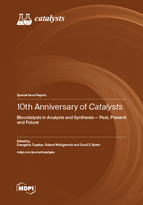10th Anniversary of Catalysts: Biocatalysis in Analysis and Synthesis—Past, Present and Future
A special issue of Catalysts (ISSN 2073-4344). This special issue belongs to the section "Biocatalysis".
Deadline for manuscript submissions: closed (31 December 2021) | Viewed by 39201
Special Issue Editors
Interests: biocatalysis; industrial biotechnology; lignocellulose degrading enzymes; novel enzymes; structure-function relationship
Special Issues, Collections and Topics in MDPI journals
Interests: bioeconomy; biocatalysis; glycobiology; metabolomics; industrial biotechnology
Special Issues, Collections and Topics in MDPI journals
Interests: enzymes; protein biophysics; allostery; protein engineering; NMR; microbiology
Special Issues, Collections and Topics in MDPI journals
Special Issue Information
Dear Colleagues,
In view of the key importance of biocatalysis and as a way of celebrating the 10th anniversary of Catalysts, the “Biocatalysis” section has taken the initiative to launch a Special Issue entitled “10th Anniversary of Catalysts: Biocatalysis in Analysis and Synthesis—Past, Present and Future”. The “Biocatalysis” section in Catalysts continues to grow, with 46 Special Issues and 409 articles published to date.
This milestone is a great time to both reflect on previous accomplishments and identify the next challenges and opportunities in “Biocatalysis”. As such, we highly encourage potential authors to be forward-thinking in their articles, by proposing important questions and obstacles in their areas of interests and means of addressing them. We are also interested in highlighting newly emerging areas for “Biocatalysis”. We believe that this Special Issue is an opportunity to identify grand themes in “Biocatalysis”.
While we intend to keep the scope of this Special Issue broad in order to adequately reflect the diversity of research within “Biocatalysis”, some areas of interest include: (i) discovery methodologies for desired enzyme functions; (ii) relationships among enzyme structure, function and mechanism; (iii) development and analysis of robust and sensitive enzyme assays; (iv) novel enzymes; (v) scalable 1-step, multi-step and total biocatalytic synthesis. The aims and scope of this Special Issue are, however, not limited to these five areas of interest and potential authors are also welcome to submit contributions on other biocatalysis topics.
It is a great honor and pleasure to invite you to contribute a review article or an original research paper for peer review and possible publication in this 10th Anniversary Special Issue.
Dr. Evangelos Topakas
Prof. Dr. Roland Wohlgemuth
Dr. David D. Boehr
Guest Editors
Manuscript Submission Information
Manuscripts should be submitted online at www.mdpi.com by registering and logging in to this website. Once you are registered, click here to go to the submission form. Manuscripts can be submitted until the deadline. All submissions that pass pre-check are peer-reviewed. Accepted papers will be published continuously in the journal (as soon as accepted) and will be listed together on the special issue website. Research articles, review articles as well as short communications are invited. For planned papers, a title and short abstract (about 100 words) can be sent to the Editorial Office for announcement on this website.
Submitted manuscripts should not have been published previously, nor be under consideration for publication elsewhere (except conference proceedings papers). All manuscripts are thoroughly refereed through a single-blind peer-review process. A guide for authors and other relevant information for submission of manuscripts is available on the Instructions for Authors page. Catalysts is an international peer-reviewed open access monthly journal published by MDPI.
Please visit the Instructions for Authors page before submitting a manuscript. The Article Processing Charge (APC) for publication in this open access journal is 2700 CHF (Swiss Francs). Submitted papers should be well formatted and use good English. Authors may use MDPI's English editing service prior to publication or during author revisions.
Keywords
- biocatalysis
- enzyme structure, function and mechanism
- enzyme assays
- discovery of novel enzymes
- biocatalytic synthesis








